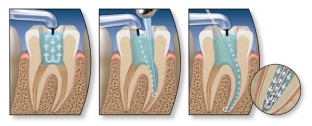Periodontitis is one of the most common diagnoses that is heard in the dental office. Treatment of periodontitis requires immediate treatment, because the focus of infection is in close proximity to the large vessels of the brain. There are several treatments for periodontitis. It is important for a specialist to immediately choose the right treatment tactics for a particular clinical case, taking into account the volume and possible complications of periodontitis.
How to cure periodontitis qualitatively and quickly? What are the features of periodontitis therapy methods? What new techniques are currently being used to treat periodontitis?
Methods of treatment of periodontitis and their disadvantages
Treatment of chronic periodontitis of the teeth has been and remains a topical issue until this time. For this, in modern dentistry, the following methods are most often used:
- Therapeutic, which is based on high-quality antiseptic and mechanical treatment of the root canal of the tooth, with further obturation of the canal and granulomas with calcium-containing materials.
- Surgical, which consists of cystectomy with resection of the apex of the root of the causative tooth. It consists of endodontic treatment of the patient (filling the tooth canal to the anatomical hole), cystectomy, resection of the apex of the tooth root (to the level of healthy bone tissue).
The above methods of treatment of chronic granulomatous periodontitis have a number of difficulties and disadvantages at the stages of their use. For the therapeutic method, multiple interventions with the use of calcium preparations and a long waiting period for a positive effect are considered disadvantages. At the same time, in some cases, exacerbation of the process was observed.
In endodontic preparation of a patient with any treatment method, an important task is to fill the root canal to the apex, which is not always possible due to some reasons:
- Presence of a denticle in the canal, sclerosis of the canal;
- Instrument breakage in canal;
- Perforation of the canal wall.

Disadvantages of surgical treatment of periodontitis and methods for their elimination.
In a surgical tooth-preserving method of treating chronic periodontitis, which is a resection of the root of the tooth, it is necessary to cut off the top of the root to the lower level of the bone wall of the bone, that is, to pathologically unchanged bone tissue. At the same time, the root canal of the tooth must be tightly obturated throughout its entire length. This will ensure that the repetition of the pathological process in the postapical part will no longer be repeated. During resection of the tooth root in pathologically unchanged places, the anatomical shape is not preserved and the biomechanics of the tooth is disturbed. And in some cases, the expediency of a tooth-preserving operation loses its meaning due to the very small size of the remnant of the tooth root after surgical intervention.
The solution to eliminate such shortcomings is the method of retrograde filling of the root canal using a Muller needle or a tip with glass ionomer materials, amalgam or cement.
As practical experience shows, bleeding during surgery and insufficient material support of the dental office, in most cases, is the reason for the impossibility of qualitative retrograde expansion canal to remove infected dentin. It is also difficult to implement a retention point that can hold the obturated material.
What is the new method of treatment of periodontitis
Recently, a method (N 24340) has been proposed that solves the problem of restoring the normal functioning and anatomical shape of the tooth root during cystectomy with resection of the root apex when high-quality endodontic treatment is impossible and increases the effectiveness of surgical intervention in the treatment of chronic periodontitis. The method was developed by the Department of Maxillofacial Surgery and Surgical Dentistry of the National Medical University named after O.O. Bogomolets of the Ministry of Health of Ukraine, the Ukrainian Association of Cranio-Maxillofacial Surgeons, and the International Academy "Dental implantation of osseointegration".
The essence of the method consists in the fact that an additional formation is made - a furrow in the root of the tooth for the unsealed part of the canal and further filling it and the furrow made with boron with glass ionomer cement.
The method is carried out as follows - after the endodontic preparation of the patient (the root canal of the tooth is filled with a filling as far as the clinical situation allows), the mucous-osseous area is cut out and exfoliated the required form, carry out trepanation of the bone in the projection of the bone (granuloma).
A cystectomy is being done. The root apex is resected within the boundaries of the branching of the microtubules. Boron open the unsealed part of the root canal from the lateral surface of the root (form a cavity for the filling). This cavity is sealed, taking into account the anatomical properties of the tooth root. After drug treatment of the bone walls of the bone, the mucosal clasp is mobilized and the wound is sutured.
Results of treatment with this method of patients with periodontitis
15 patients were operated on using this technique. The postoperative period was typical, there were no complications. 6-8 months after the operation, during X-ray examination, in all patients, a bone pattern was found in the periapical tissue of the operated teeth, which corresponds to the term for creating young bone tissue. A year after the operation, X-ray examination of the periapical tissue (sighted image), no relapses were observed.
The method is easy to implement, not expensive, and, most importantly, it makes it possible to eliminate the problem qualitatively.
Therefore, today the tactics of treating periodontitis will not be difficult and will not take much time. This is for the benefit of both the dentist and the patient, because the symptoms and possible complications of periodontitis are quite unpleasant and dangerous. Daily proper oral hygiene and regular visits to the dentist will not leave a chance for periodontitis.






Add a comment